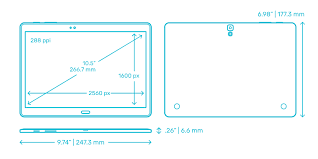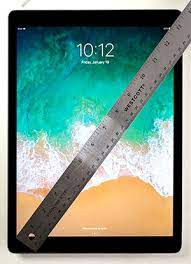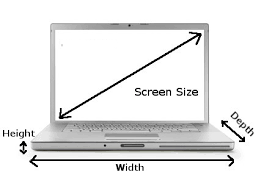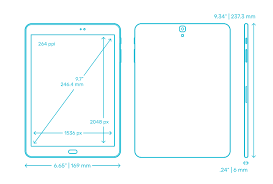Introduction
Tablets have evolved from simple consumption devices into versatile productivity tools. And it is often rivaling laptops in functionality. However, with a plethora of options on the market, it’s crucial to understand that, how tablets are measured and what factors determine their suitability for your needs. This guide will explore seven key areas where tablets are evaluated. And to ensuring you make an informed decision when choosing your next device.
1. Screen Size and Resolution
Screen size and resolution are two critical factors in determining the visual quality and user experience of any display device, including televisions, computer monitors, laptops, tablets, smartphones, and more.
Screen Size:
The screen size refers to the diagonal measurement of a monitor or display from one corner to its opposite corner. It usually expressed in inches. The choice of screen size depends on the intended use and viewing distance. For example, larger screens (50 inches and above) are typically used for home theaters or living room TVs, where viewers sit farther away. Smaller sizes (13-17 inches) are common for laptops and some desktop monitors, while medium-sized screens (21-32 inches) are popular for office work or personal computing.
Resolution:
Resolution is the number of pixels (individual points of color) that a screen can display horizontally and vertically. It’s often represented as width x height, with the most common format being pixels per inch (PPI) or dots per inch (DPI).
For instance, Full HD resolution is 1920×1080 pixels, meaning it has 1920 pixels across and 1080 pixels down. A higher resolution like Quad HD (2560×1440) or 4K Ultra HD (3840×2160) packs more pixels into the same screen area, resulting in a sharper, clearer image with more detail.
A high-resolution display on a smaller screen will result in very crisp text and visuals, ideal for tasks requiring fine detail such as graphic design or photo editing. Larger screens with lower resolutions may have visible pixelation, whereas larger screens with high resolutions provide an immersive experience, especially for gaming and watching high-definition content.
In summary, screen size affects how much information you can view at once and your overall immersion, while resolution determines the sharpness and clarity of the displayed image. The optimal combination of these features depends on your specific needs and preferences.
2. Processor and Performance
Processing Power:
A tablet‘s processor determines its speed and ability to handle demanding tasks. Look for processors like Qualcomm Snapdragon, Apple’s A-series, or high-end Intel and AMD chips for performance-intensive activities such as gaming, video editing, or running multiple apps simultaneously.
RAM and Storage:
RAM (Random Access Memory) influences how well a tablet can handle multitasking. Higher RAM capacity ensures smoother operation when switching between applications. Storage, usually measured in GBs or TBs, dictates how much data you can store locally. Consider expandable storage options or cloud integration if you deal with large files.
3. Operating System
iOS vs Android vs Windows:
Operating systems play a pivotal role in determining the user experience and available software. iOS offers seamless integration with Apple’s ecosystem, excellent security, and a curated app store. Android provides flexibility, customization, and a vast selection of apps, while Windows-based tablets offer full PC capabilities and compatibility with Microsoft Office suite.
4. Battery Life
Battery life is one of the most critical aspects of a tablet’s usability. It’s typically measured in hours and reflects the average usage time before requiring a recharge. Factors like screen brightness, resolution, and usage patterns affect battery longevity. Aim for at least 8-10 hours of mixed-use battery life for all-day productivity or entertainment.
5. Connectivity Options
Wi-Fi and Cellular:
Most tablets come with Wi-Fi connectivity as standard. For constant internet access on-the-go, consider a cellular-enabled model that supports LTE or the latest 5G networks. Keep in mind that cellular models often come at a premium price and may require separate data plans.
Ports and Expandability:
Check for USB-C or Thunderbolt ports for fast charging, data transfer, and connecting external displays or peripherals. Some tablets still include headphone jacks, microSD card slots for storage expansion, or proprietary docking connectors for added versatility.
6. Weight and Build Quality
Portability is a significant factor for many tablet users. Lighter tablets, typically under 1 pound, are easier to hold and carry around. However, weight should be balanced against durability. Materials like aluminum, magnesium alloy, or Gorilla Glass contribute to a robust build quality that withstands daily wear and tear.
Form Factor and Design:
Consider whether a traditional slate-style tablet, a hybrid with a detachable keyboard, or a 2-in-1 with a 360-degree hinge suits your lifestyle best. The form factor affects both usability and overall dimensions.
7. Accessories and Integration
Accessories and integration play a significant role in enhancing the functionality, convenience, and versatility of electronic devices, including computers, smartphones, home entertainment systems, and smart home appliances.
Accessories:
Accessories are supplementary items that improve or expand the capabilities of your device. Examples include:
- Input Devices: Keyboards, mice, touchpads, styluses, joysticks, and game controllers for improved interaction with devices.
- Protection and Portability: Cases, sleeves, screen protectors, stands, and bags to safeguard devices during transport and everyday use.
- Power and Charging: Power banks, chargers, charging docks, cables, and adapters to keep devices powered up.
- Audio and Visuals: Headphones, speakers, webcams, microphones, and external displays to enhance audiovisual experiences.
- Storage and Connectivity: USB drives, SD cards, hubs, docking stations, and dongles to increase storage capacity and expand connectivity options.
- Enhanced Functionality: Tripods, lenses for smartphone cameras, VR headsets, fitness trackers, and smartwatch bands to customize and optimize device performance for specific tasks or hobbies.
Integration:
Device integration refers to how well devices work together and communicate within a system or ecosystem. This could involve:
- Software Compatibility: Ensuring apps, operating systems, and software suites are compatible across various devices.
- Smart Home Integration: Connecting devices like smart lights, thermostats, security cameras, and voice assistants to create an interconnected home automation system, often controlled through platforms like Google Home, Amazon Alexa, or Apple HomeKit.
- Cloud Services: Seamless syncing of data, files, and settings across multiple devices using cloud services like iCloud, Google Drive, or Microsoft OneDrive.
- Cross-Platform Support: The ability to share content, control one device from another (e.g., using a smartphone to control a TV), or perform actions across different brands or types of devices.
The right accessories can significantly improve user experience and productivity, while seamless integration allows for convenient and efficient operation across all your devices. When choosing devices, it’s essential to consider both their standalone features as well as their compatibility with existing ecosystems and available accessories.
Conclusion
In conclusion, measuring a tablet involves assessing various attributes that collectively define its utility and value. From screen size and performance to battery life and ecosystem integration, each aspect contributes to the perfect balance of power, portability, and convenience. By understanding these metrics and weighing them according to your priorities, you’ll be able to select a tablet that not only meets but exceeds your expectations. Remember, there’s no one-size-fits-all solution; the best tablet is the one that aligns with your unique needs and preferences.